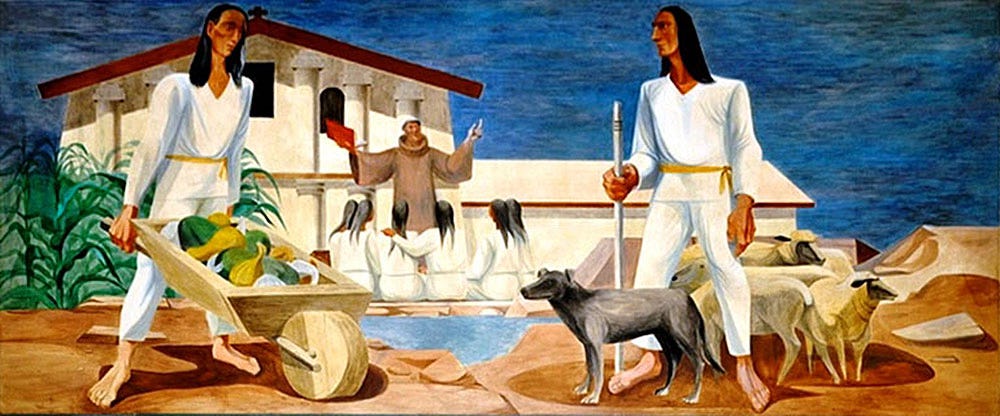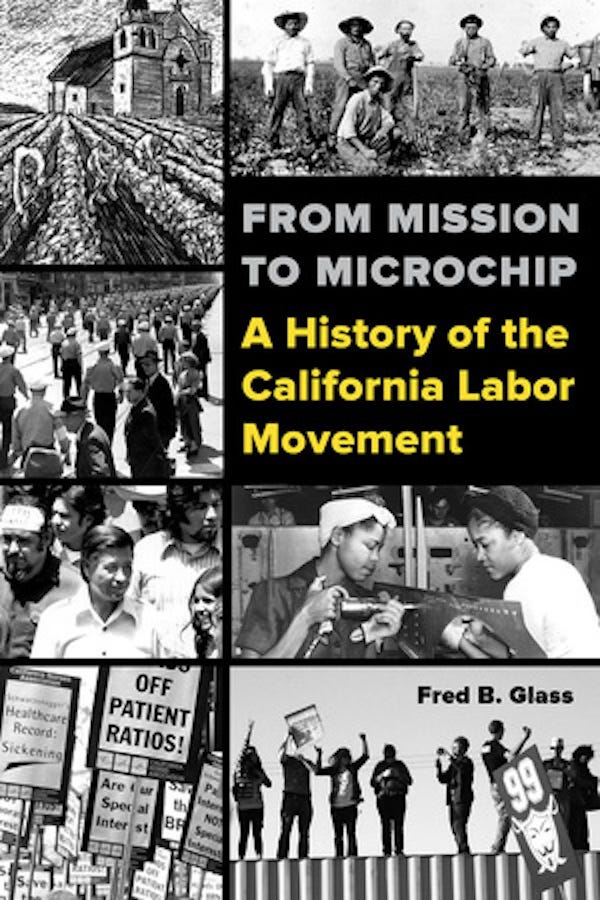The Labor History Corner
An excerpt from From Mission to Microchip: A History of the California Labor Movement By Fred Glass
A version of this article appeared on the California Labor Federation California Labor History website. You can buy From Mission to Microchip: A History of the California Labor Movement from the University of California Press.
On a Mission: The first California farmworkers
In 1769, when the first Mission was established by the Spanish empire in Alta California, there were about 300,000 California Indians.* What became “California” was one of the most densely populated regions of the pre-Columbian world—although that population represents less than one per cent of the population in California today. By 1833, fewer than half remained. What happened to 50% of the California Indians within the span of one lifetime?
Early California Indians had no conception of linear history, so far as we know; nor, given their way of life, did they need one. The bounty of nature was so extraordinary only a few tribes practiced agriculture. They viewed time as cyclical. The concept of “work” according to a clock was unknown to them.
All this would change once the Spanish came. Under the mission system, the Spanish reorganized the Indians from tribes whose lives included work, into a workforce. This transformation disrupted and eventually destroyed the traditional subsistence economies and cultures that had flourished for thousands of years.
On a Mission

The first workers were Baja California Indians, who had learned agricultural and construction skills in the missions and pueblos south of the new territories. Without these pioneering but nameless to history Baja field hands, the padres might have failed to establish the missions.
Once established, the missions became the hub of the economic life of the Spanish colony. At the center of the hub was native Californian labor. The padres brought in Spanish and Mexican craftsmen to train the Indians in various crafts. These Indian workers then made crucial contributions to a number of early California industries without being able to enjoy a reasonable share of what they produced. They received food, shelter, religious and vocational instruction, and clothing (and not much of that) in exchange for work—not wages. The mission economy was pre-capitalist, so far as the native Californians were concerned.
Getting the Indians to adjust to working in these ways required strict regimentation and harsh discipline. The “neophytes” (the term for Native Americans as they were trained) lived in an atmosphere of repression and intolerance, and the work they performed was forced labor.
Unlike many slaves in the southern United States at the same time, Native Americans did not work twelve hour days in the missions: at thirty to forty hours per week, they were not literally worked to death. Nor were they ‘owned’ by the padres. But the regulation of the day by the padres into a rigid schedule announced by church bells, reinforced by punishments for breaking the rules, ran completely counter to Native American traditions.
No wonder the “neophytes” came up with various forms of resistance. Many left the missions and didn’t return unless forced to. Theft was frequent. Occasionally Indians assassinated padres. Armed revolt broke out from time to time almost from the first days of the missions, ranging from individual attacks on soldiers or padres to battles involving hundreds of Indians.
Creation of a Surplus
Native American labor founded many of California’s industries. The Indians generated agricultural products, and textile, leather, wood and metal goods, with which the missions supplied the adjacent presidios (military stockades) and traded with nearby pueblos and foreign ships for otherwise unavailable items. But while the mission storerooms held grains, vegetables, dairy products, and fruit and wine, the neophytes were fed a monotonous diet based on oatmeal or cornmeal mush called atole. While varying from mission to mission, hunger—and even starvation—was often cited by runaways as one main reason for escaping. Another was the frequent beatings.
Malnutrition weakened the Native Americans’ resistance to disease. In their traditional villages, the nomadic Indians would simply burn down their always-temporary homes and move to establish new ones to deal with flea infestations or epidemics. In the missions, the Indian men and women, forced to live in permanent buildings, suffered from crowding and unsanitary conditions, which in turn facilitated the spread of European diseases such as measles, syphilis, and tuberculosis, against which the Native Americans had no immunities.
Forced labor, diet, living conditions, disease: these factors contributed to a high death rate and low birth rate. Work itself was not the immediate cause of the horrible population decline of the Native Americans. It would, however, be accurate to blame the coerced labor system of the missions, since the Indians were brought to the missions primarily to work.
For thousands of years before the Spanish came, the work of the Indians provided for living. From the Spanish point of view, it was the other way around: the Indians lived to work for them. The precipitous loss of half the Native Californians within a single lifetime followed their transformation from free subsistence hunter-gatherers into a class of coerced laborers, forced to create a surplus for their Spanish masters.
*Some Native Californians prefer to be called Indians, and some, Native Americans. We use the terms interchangeably.
Fred Glass is the author of From Mission to Microchip: A History of the California Labor Movement (UC Press, 2016) and a member of the State Committee of California DSA
Stay tuned for next week’s installment…



